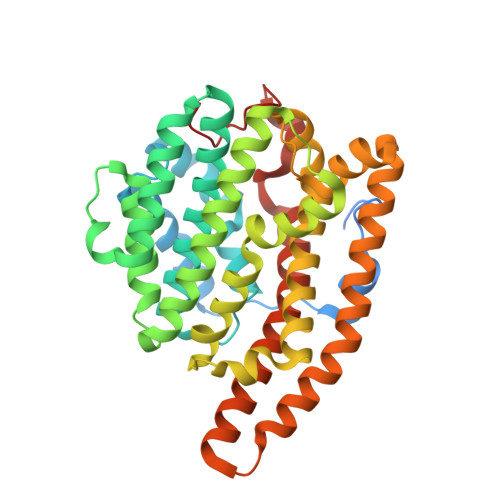Reprogramming the Cyclization Cascade of epi -Isozizaene Synthase to Generate Alternative Terpene Products.
Eaton, S.A., Christianson, D.W.(2023) Biochemistry 62: 2301-2313
- PubMed: 37449555
- DOI: https://doi.org/10.1021/acs.biochem.3c00247
- Primary Citation of Related Structures:
8SU0, 8SU1, 8SU2, 8SU3, 8SU4, 8SU5 - PubMed Abstract:
The class I sesquiterpene cyclase epi -isozizaene synthase from Streptomyces coelicolor (EIZS) catalyzes the transformation of linear farnesyl diphosphate (FPP) into the tricyclic hydrocarbon epi -isozizaene in the biosynthesis of albaflavenone antibiotics. The active site cavity of EIZS is largely framed by four aromatic residues - F95, F96, F198, and W203 - that form a product-shaped contour, serving as a template to chaperone conformations of the flexible substrate and multiple carbocation intermediates leading to epi -isozizaene. Remolding the active site contour by mutagenesis can redirect the cyclization cascade away from epi -isozizaene biosynthesis to generate alternative sesquiterpene products. Here, we present the biochemical and structural characterization of four EIZS mutants in which aromatic residues have been substituted with polar residues (F95S, F96H, F198S, and F198T) to generate alternative cyclization products. Most notably, F95S EIZS generates a mixture of monocyclic sesquiterpene precursors of bisabolane, a D2 diesel fuel substitute. X-ray crystal structures of the characterized mutants reveal subtle changes in the active site contour showing how each aromatic residue influences the chemistry of a different carbocation intermediate in the cyclization cascade. We advance that EIZS may serve as a robust platform for the development of designer cyclases for the generation of high-value sesquiterpene products ranging from pharmaceuticals to biofuels in synthetic biology approaches.
Organizational Affiliation:
Roy and Diana Vagelos Laboratories, Department of Chemistry, University of Pennsylvania, Philadelphia, Pennsylvania 19104, United States.


















